Volume 16, Issue 5 (September-October 2017)
Payesh 2017, 16(5): 637-645 |
Back to browse issues page
Ali Asghar Haerimehrizi 
 , Mahmoud Tavousi
, Mahmoud Tavousi 
 , Jila Sadighi
, Jila Sadighi 
 , Mohammad Esmaeil Motlagh
, Mohammad Esmaeil Motlagh 
 , Mohammad Eslami
, Mohammad Eslami 
 , Fatemeh Naghizadeh
, Fatemeh Naghizadeh 
 , Ali Montazeri
, Ali Montazeri 


 , Mahmoud Tavousi
, Mahmoud Tavousi 
 , Jila Sadighi
, Jila Sadighi 
 , Mohammad Esmaeil Motlagh
, Mohammad Esmaeil Motlagh 
 , Mohammad Eslami
, Mohammad Eslami 
 , Fatemeh Naghizadeh
, Fatemeh Naghizadeh 
 , Ali Montazeri
, Ali Montazeri 

Abstract: (7321 Views)
Objective (s): During recent years fertility rate is decreasing in Iran. This study aimed to assess reasons for fertility desire and disinterest among Iranian married adults.
Methods: This was a population-based study. A sample of married individuals living in all 31 provinces in Iran enteed into the study and were asked whether they intend to have a child at present. Participants were interviewed via a structured questionnaire including items on socio-demographic and reproductive information. Participants were asked to indicate reasons for desire or disinterest for fertility. Participants were free to name several reasons as they wish. Descriptive analysis was used to explore the data.
Results: In all 20935 individuals (10388 male and 10547 female) were interviewed. The mean age of participants was 36.28 (SD= 8.23) years. Overall 31.8% of respondents indicated that they wish to have a child while the remaining 68.2 said that they did not. The most important reason for fertility desire was interest in having children (93.5%), followed by wish to experience parenthood (92.2%). The most important reason for disinterest for fertility was worryness about the future of a new child (76.1%) followed by economic problems (71.0%).
Conclusion: The findings suggest that willingness to experience parenthood and economic hardship are the most common reasons for fertility desire or fertility disinterest respectively. Perhaps interventions aiming to focus on joyful parenhood experiences might be helpful to encourgare young couples for having children.
Methods: This was a population-based study. A sample of married individuals living in all 31 provinces in Iran enteed into the study and were asked whether they intend to have a child at present. Participants were interviewed via a structured questionnaire including items on socio-demographic and reproductive information. Participants were asked to indicate reasons for desire or disinterest for fertility. Participants were free to name several reasons as they wish. Descriptive analysis was used to explore the data.
Results: In all 20935 individuals (10388 male and 10547 female) were interviewed. The mean age of participants was 36.28 (SD= 8.23) years. Overall 31.8% of respondents indicated that they wish to have a child while the remaining 68.2 said that they did not. The most important reason for fertility desire was interest in having children (93.5%), followed by wish to experience parenthood (92.2%). The most important reason for disinterest for fertility was worryness about the future of a new child (76.1%) followed by economic problems (71.0%).
Conclusion: The findings suggest that willingness to experience parenthood and economic hardship are the most common reasons for fertility desire or fertility disinterest respectively. Perhaps interventions aiming to focus on joyful parenhood experiences might be helpful to encourgare young couples for having children.
type of study: Descriptive |
Accepted: 2017/09/4 | ePublished ahead of print: 2017/09/23 | Published: 2017/09/15
Accepted: 2017/09/4 | ePublished ahead of print: 2017/09/23 | Published: 2017/09/15
| Rights and Permissions | |
 |
This work is licensed under a Creative Commons Attribution-NonCommercial 4.0 International License. |

